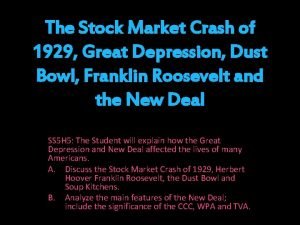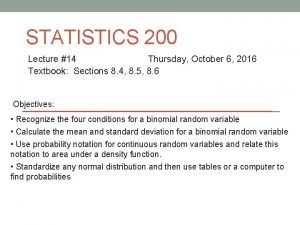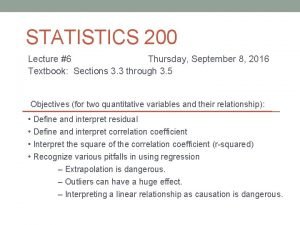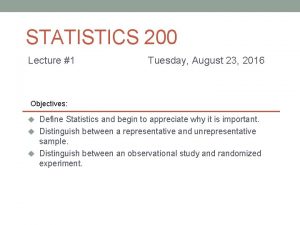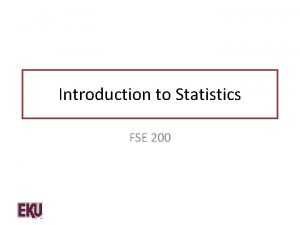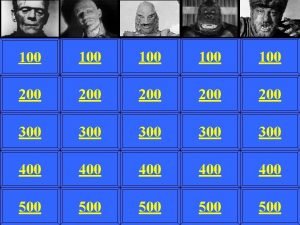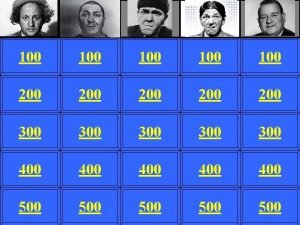STATISTICS 200 Lecture 2 Thursday August 25 2016



















- Slides: 19

STATISTICS 200 Lecture #2 Thursday, August 25, 2016 Objectives: Distinguish between: - A statistic and a parameter - A categorical and a quantitative variable - A response and an explanatory variable Identify: - When a categorical variable is ordinal - When a quantitative variable is continuous - Appropriate numerical & visual summaries for categorical variables

What do data look like? • Usually, a spreadsheet, and sometimes it’s messy! • Ideally, a dataset will provide all of the values for each observation. Sometimes there is missing data. • This type of data is called raw data. • It’s very hard to see patterns in raw data.

Key terms: variable and observation • A variable is a characteristic that can differ from one individual to the next. • An observational unit is a single individual who participates in a study. • Also called an observation. • The sample size is the total number of observations.

Key terms: Parameters and Statistics Population A parameter is a summary measure for the entire population. Example: Proportion of all PSU students that live in a dorm Sample A statistic is a summary measure for a sample. Example: Proportion of students in this classroom that live in a dorm

Section 2. 2: Types of variables • A categorical variable consists of group or category names. Example: - Living situation - Eye Color • A quantitative variable consists of numerical measures or counts. Example: - Height - GPA

Special types of variables Categorical Examples: A categorical Ordinal variable whose categories have a logical ordering Agreement with the statement: “I depend on my smartphone” Response: strongly disagree, neutral, How many drinks did you have during finals week? Response: 0, 1 to 3, 4 to 7, 8 or more agree, strongly agree

Special types of variables Numerical A quantitative variable that can take on any value within some interval. Continuous Examples: Weight, measured in pounds Time to run a 5 k, measured in minutes Length of stride, measured in inches Numerical but not continuous: discrete (more on this in Chapter 8)

Explanatory vs Response Variables • An explanatory variable is one which is thought to (partially) explain a difference in the response variable. Examples: • Height and Weight • Sex and Height • Age and Reading distance • Education level and income

2. 3: Summarizing one or two categorical variables Numerical Summaries Tables of counts and percentages Graphical Summaries Pie Charts Bar Graphs

2. 3: Numerical Summary • Use a table to display how many observations are in each category. • Counts

2. 3: Numerical Summary • Use a table to display how many observations are in each category. • Counts • Percent of observations in each category also displayed. Percent = Count / Total

Two-way tables • With one variable, we use a one-way table. • With two variables, we use a two-way table. Each cell shows the count and row percent for the corresponding variable categories 106: Number of observations who answered ‘female’ and ‘Yes’ 18. 56: Percent of females that answered ‘Yes’.

Statistical picture for one categorical variable However, pie charts are a very bad way of displaying information. The eye is good at judging linear measures and bad at judging relative areas. A bar graph works too.

Statistical picture for one measurement variable Note: “Measurement” = “Quantitative” = “Numerical” Either a histogram or a boxplot could work

Statistical picture for two categorical variables This bar graph, or bar chart, shows counts for subgroups defined by both sex and eye color.

Statistical picture for two measurement variables Note: “Measurement” = “Quantitative” = “Numerical” In this scatterplot, the diagonal line shows actual=ideal.

March 2005 poll: Do you agree with the court decision to remove Terry Schiavo’s feeding tube? Source: http: //mediamatters. org/items/200503220005

CNN. com updated its graphic a few days later: Old graph: Source: http: //mediamatters. org/items/200503220 005

Review: If you understood today’s lecture, you should be able to solve • 2. 1, 2. 3, 2. 15, 2. 19, 2. 21, 2. 29, 2. 27, 2. 30, 2. 31 Review of Objectives: Distinguish between: - A statistic and a parameter - A categorical and a quantitative variable - A response and an explanatory variable Identify: - When a categorical variable is ordinal - When a quantitative variable is continuous - Appropriate numerical & visual summaries for categorical variables
 200+100+300
200+100+300 01:640:244 lecture notes - lecture 15: plat, idah, farad
01:640:244 lecture notes - lecture 15: plat, idah, farad Medical statistics lecture
Medical statistics lecture 100 + 100 + 200
100 + 100 + 200 300 + 200 + 200
300 + 200 + 200 200+200+100
200+200+100 200+200+100+100
200+200+100+100 200+200+300+300
200+200+300+300 200+400+600+800
200+400+600+800 Introduction to statistics what is statistics
Introduction to statistics what is statistics Black sunday stock market crash
Black sunday stock market crash Welcome thursday
Welcome thursday Oeoes uc davis
Oeoes uc davis Thursday question of the day
Thursday question of the day Thursday night prayer
Thursday night prayer 997ni1xcmkw -site:youtube.com
997ni1xcmkw -site:youtube.com On thursday we visited
On thursday we visited Saturday sunday monday tuesday wednesday thursday friday
Saturday sunday monday tuesday wednesday thursday friday Thursday bell ringer
Thursday bell ringer Easter traditions uk
Easter traditions uk










